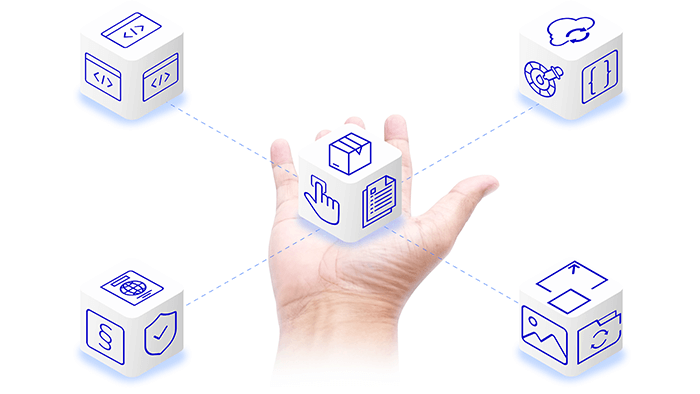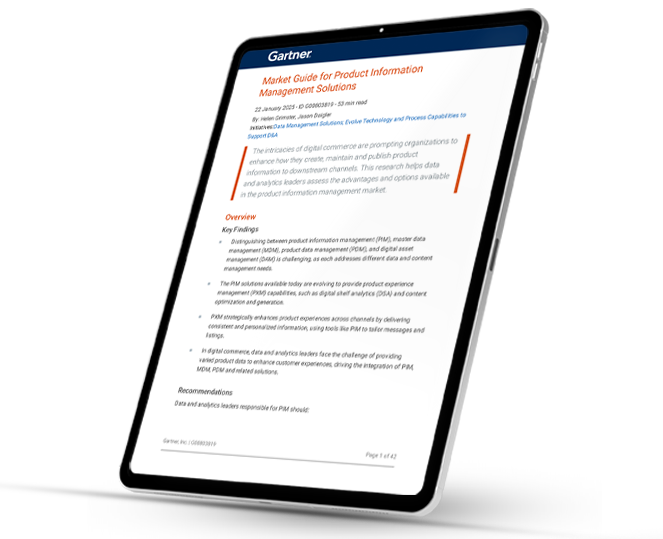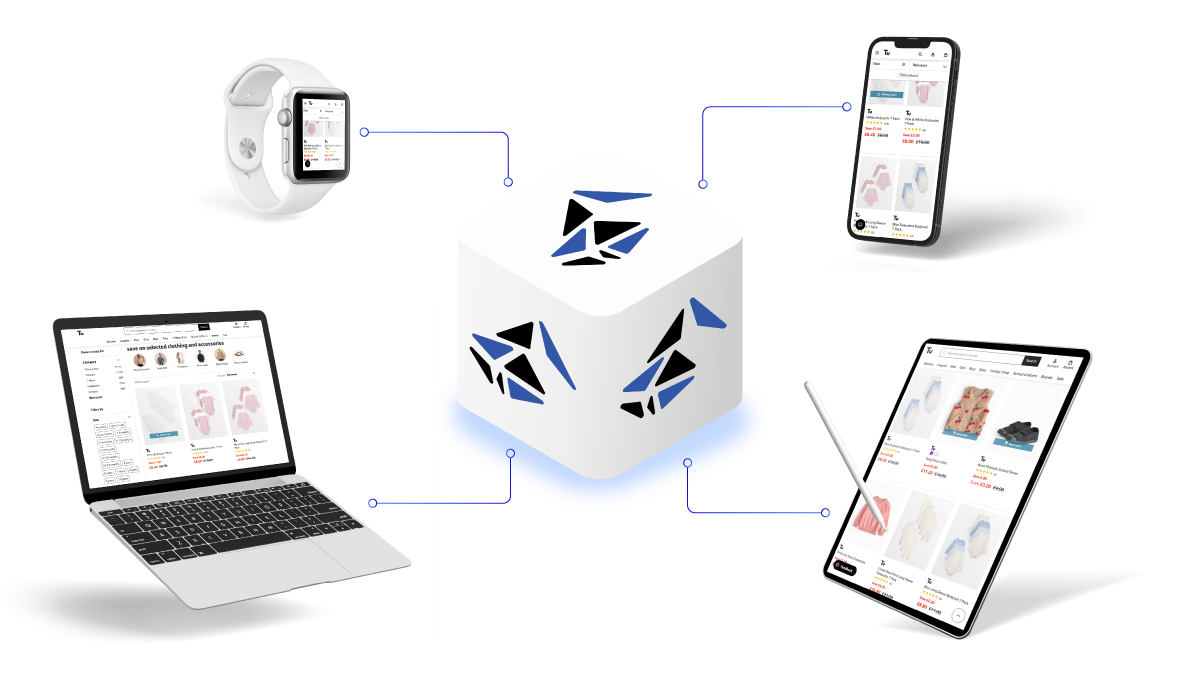An Essential Guide to Composable Enterprise Architecture

Business moves fast. With customer expectations for personalisation rising and AI reshaping the industry, rigid legacy systems can no longer keep up.
To stay competitive, you need flexibility. This article unpacks Composable Enterprise Architecture, a strategy that allows your business to adapt instantly to new opportunities without the need to rebuild your entire system.
Summary of the Guide to Composable Enterprise Architecture
-
Flexible 'building blocks': Move away from rigid, all-in-one systems. This approach breaks technology into small, independent modules that can be swapped or updated individually without breaking the whole system.
-
Speed and adaptability: Businesses can react to market changes instantly. You can launch new features faster and scale your technology up or down easily during busy periods. Learn more about the Composable PIM.
-
Seamless connections: Using digital 'bridges' known as APIs, different software tools talk to each other perfectly. This ensures customers get a consistent experience whether they are shopping online or in-store.
-
Future-proofing: You do not need to rebuild your system from scratch every few years. You simply replace outdated parts with the best new tools as they emerge, keeping your organisation modern and efficient.

DOWNLOAD FREE E-BOOK
Gartner® Market Guide for Product Information Management Solutions
The 2025 Gartner® Market Guide for Product Information Management is a trusted resource for business and tech leaders who want to make a confident decision about their PIM solution.
Managing thousands of SKUs in e-commerce?
Get monthly tips to become the e-commerce pro your team needs.
What Is Composable Enterprise Architecture?
Think of it like a castle made of building blocks (like LEGO), rather than one carved from solid stone.
If you want to change a window on the stone castle, you have to chip away at the whole structure, which is difficult, messy, and risks damaging the foundation.
With building blocks, you simply unclip the old window and snap a new design in its place. You can swap parts, add a new wing, or change the colours without disturbing the rest of the castle.
Composable Enterprise Architecture applies this logic to your business. Instead of one rigid system, it breaks your software into modular parts. This allows you to update, replace, or scale specific components independently, ensuring your system remains flexible and easy to manage.
Some of the key elements and functions of composable enterprise architecture are:
-
Application Programming Interfaces (APIs) are used to assemble enterprise processes.
-
Partners and customers can access organizational processes and data via APIs.
-
It allows businesses to access data and create front-end applications when the need arises.
-
It’s a scalable form of architecture, meaning it can help businesses meet changing demands quickly.
-
Security is part of every building block, which means it’s intrinsic throughout.
-
Solutions are bottom-up rather than top-down.
The principles of composable enterprise architecture closely align with MACH architecture, which stands for Microservices, API-first, Cloud-native, and Headless. Both emphasize flexibility, scalability, and modularity.
While composable architecture integrates modular components to create adaptable systems, MACH provides a framework that applies these principles across various domains, including digital commerce and content management systems.
Traditional vs. Composable Architecture
Composable architecture particularly stands out in one area where traditional models often struggle: managing the dynamic demands of digital data storage.
Traditional storage models, such as network-attached storage (NAS) and storage area network (SAN), have been supporting businesses well for decades and continue to play a key role in business today.

Source: lifewire.com
NAS systems allow many users to access data from shared storage via LAN. It has built-in security and is generally one of the cheaper storage options. However, problems can arise when they encounter unexpected, heavy traffic.
SAN can offer a solution by utilizing multiple interconnected storage systems. This allows greater scalability, but it also comes at a cost. Maintenance can be complex and expensive, and the system doesn’t always meet expectations.
On top of this, data is growing at an unprecedented rate, particularly within enterprise data centers. This rapid expansion is projected to see the volume of digital data created and stored worldwide increase from 33 zettabytes in 2018 to 175 zettabytes by 2025.
Alongside evolving workflows and application technologies, this makes it clear that traditional methods are not viable for managing diverse and dynamic data storage needs in the near future.
Enterprise architecture (EA) is a way of addressing these shortfalls by segregating storage. Each element can be composed or recomposed as applications change, and storage can be allocated when needed and released when not in use so that other applications can access it.
It’s a way of responding to unpredictable or changing storage needs. It is, however, still a relatively young technology that is still maturing.
Why You Should Adopt a Composable Approach in E-commerce
The flexibility of composable architecture can help retailers modernize their e-commerce and tech stacks, and that is why many companies are replatforming towards a composable IT architecture.
Here, we’ll look at the three reasons an enterprise should adopt a composable commerce approach:
It Can Enhance Agility and Scalability
One great benefit of composable architecture is the ability to proactively and reactively scale your platform.
You can anticipate future needs and adjust resources in advance, such as increasing server capacity before a major sales event, while also responding to unexpected changes in real-time, like quickly scaling up infrastructure to accommodate sudden traffic spikes during peak shopping seasons like Labor Day sales or Black Friday.
Conversely, during quieter periods, you can scale down to optimize costs.
In addition to scalability, the modular design of the composable architecture enables enterprises to quickly adapt to changing market conditions by modifying or replacing individual components of their e-commerce and tech stack without the need to overhaul the entire system.
It is this flexibility that enables rapid deployment of new features, integration of emerging technologies, and swift responses to customer demands.
It Can Accelerate Time-To-Market for New Products and Features
Cloud-native services, which are integral to composable architecture, and reusable components offer significant benefits by reducing development time and costs.
These services leverage cloud infrastructure to provide scalable and flexible environments that are always ready to adapt. In the cloud environment, developers can use pre-built, reusable components to assemble applications quickly and avoid the need to build from scratch.
This combination streamlines the development process and allows businesses to bring new products to market faster.
Gartner predicts that by 2025, financial companies that have adopted a composable technology strategy will experience 30% higher revenue than their traditional-minded peers.
A composable architecture allows CFOs the flexibility and nuance to build a strategy that incorporates sustainable differentiation and innovative new processes while still providing a secure and cost-effective base to support core finance processes.
— Nisha Bhandare, VP analyst, research, in the Gartner Finance practice
It Can Elevate Customer Experience and Satisfaction
Personalization and an effective omnichannel strategy are key to enhancing customer experience and satisfaction. Composable architecture supports these goals by enabling businesses to tailor interactions and deliver consistent experiences across all touchpoints.
Because you can leverage the best components for your e-commerce and tech stack, you can significantly improve the speed and performance of your website and ensure a smooth user experience.
Also, because both omnichannel and AI integration are seamless, customers will enjoy consistency in support, communication, and service across all touchpoints. From IP phone systems for small businesses to online chat and in-person customer assistance, the standard of service will feel the same, no matter where customer engages with you.
Furthermore, by leveraging advanced analytics, you can gain deeper insights into the preferences of your customers and provide highly personalized communication and product recommendations to them.
4 Core Components of Composable Enterprise Architecture
Let’s now discuss the four key principles on which composable enterprise architecture is based:
1. Modular Design Principle
Monolithic architecture can hold businesses back with its rigid structure where components are tightly coupled, meaning any change to one part often requires changes to the entire system. In contrast, the modular approach of composable enterprise architecture allows developers to use pre-built microservices and packaged business capabilities (PBCs).
These components can help create a minimum viable product much faster since they are interchangeable and can be recomposed to meet new needs and changing customer demands.
Microservices and PBCs can be uncoupled completely when they no longer meet requirements and swapped with new services or features from different vendors. This means you can choose integrations that better meet your requirements and ensure that each component is optimized for your business needs.
2. Microservices and Containerization
Microservices are small, self-contained units of software that handle specific tasks or functions within an application. Each microservice operates independently but collaborates with others to form a complete application. To effectively manage and deploy these microservices, containerization is used.
Containerization provides isolated environments for each microservice to run in. Containers share the same operating system core but remain isolated from one another, ensuring that changes to one microservice do not impact others. This setup facilitates consistent and efficient deployment across various environments, whether in the cloud or on-premises.
If there is a need to make changes or scale any part of the system, you don’t need to build a completely new version of the software. Instead, you can focus on making the necessary changes or scaling the specific microservices involved, ensuring that the rest of the application remains unaffected.
Together, microservices and containerization enable businesses to build, scale, and modify applications more efficiently.
3. API-Centric Infrastructure
An API-centric infrastructure, especially with an API-first approach, offers greater flexibility and control.
By prioritizing APIs in the design process, you ensure they are central to the system’s architecture, allowing you to build around the customer's needs and focus on their experience. This approach enables you to create the best possible interface to meet their needs from the start, rather than having to retrofit an API around an existing interface.

Source: apitoolkit.io
An API-centric approach helps avoid technical debt by ensuring that APIs are designed with foresight and consistency from the beginning. This foresight leads to more cohesive and efficient integration and helps prevent complications and additional costs associated with retrofitting or adapting APIs later.
As a result, developers can create code once and distribute it seamlessly across all channels and interfaces to guarantee long-term maintainability and efficiency.
4. Event-Driven Architecture
Event-driven architecture focuses on handling events—changes or actions within a system. It revolves around the publishing, storage, and processing of these events. As data is transferred through the architecture, it can be tracked and its value can evolve over time.
This approach enables applications to react instantly to data changes, enhancing the system’s ability to handle dynamic and complex interactions.
By using EDA, businesses can ensure timely and relevant notifications, such as alerting customers about new product launches or updates. This method not only supports real-time operations but also ensures that the system remains adaptable and responsive to evolving needs.
How to Implement a Composable Architecture for E-commerce
When implementing a composable architecture for e-commerce, there are several key steps to incorporate into your strategy.
Here’s what you need to do first:
1. Assess Current Infrastructure and Applications
A full review of your current infrastructure can help you determine whether a composable architecture will work for you. This assessment will identify whether you need to modify the backend of your existing system or if it can be adapted with composable components, so you can potentially save costs if no significant changes are required.
It’s also important to look at the specific needs and expectations of your business. This will help you identify the microservices that you’ll need to incorporate to make the most of your system.
Enterprise architecture management (EAM) can support this assessment by providing a structured approach to analysis, planning, and realignment of systems to ensure you do it right from the start.

Source: linkedin.com
2. Select Suitable Components for Existing Systems
Choosing the right components for your existing systems is crucial to ensuring your composable architecture meets your needs effectively. However, it can be difficult to make the right choices if you’re unsure of what to look for.
To navigate this, consider working with a digital agency or service integrator who can provide expertise in selecting suitable components and assist with integration to ensure a seamless implementation.
Additionally, using an enterprise architecture tool can help identify gaps in your current systems and assist with planning and visualization. This ensures that you select the right components and integrate them correctly to optimize your architecture.
3. Design an Architecture Blueprint
An effective architecture blueprint is the foundation for implementing a composable architecture. This blueprint should provide an overview of the capabilities and applications needed to support business functions. A well-designed roadmap can then detail how these applications will interact to meet the needs of the business.
The blueprint brings together all the strategies, roadmaps, and integrations and serves as a guide for implementing a system that aligns with the business’s goals. Implementation platforms that offer tools and libraries can help build and manage these connections effectively.
4. Test and Validate Architecture Performance
Once your composable architecture is in place, the next crucial step is to thoroughly test and validate its performance before launching. This ensures that it functions well and provides a good customer experience. Any bugs or problems found during testing can then be rectified before the system goes live.
There are four main ways to test composable architecture:
-
Unit testing: This involves checking individual components in isolation to ensure they function correctly before integration.
-
Integration testing: This step checks how well the components work together within the system.
-
Contract testing: This method ensures that each component adheres to its API contracts, verifying that communication between components is reliable.
-
End-to-end testing: This final step determines whether the entire system works as a cohesive whole and delivers the expected outcomes.
5. Train Your Team
The skills needed for composable architecture differ from those needed for monolithic development. It’s important to assess the capabilities of your team to identify gaps and determine where training is needed.
This might involve bringing in external experts, such as developers with specific expertise in composable systems, to provide targeted training.
Training should extend to both technical and non-technical members of your team so as to ensure that everyone can effectively interact with the new system. The success of a composable architecture depends not just on its design but also on how well your team can operate, manage, and adapt to it.
6. Continuously Monitor and Optimize
Identifying the goals of composable architecture at the start helps ensure you’ve met them after implementation. Once you have the system in place, ongoing monitoring and optimization are essential to ensure it continues to meet those goals and delivers optimal performance.
Why, you might ask? It's because unexpected problems can arise for several reasons, including:
-
Inadequate initial planning, such as not gathering enough information, setting unclear goals, or failing to align with organizational objectives, can lead to suboptimal outcomes.
-
Building a system that lacks scalability may hinder growth and adaptability.
-
Insufficient security measures may expose the system to vulnerabilities.
Being proactive and regularly monitoring your composable architecture allows you to identify and address any issues early before they cause serious damage. With continuous optimization, you can ensure your system’s performance remains at its peak.
Key Takeaways
Ever-growing product portfolios, shifting customer expectations, and rapid technological advancements pose significant challenges for enterprises today. These pressures make it challenging for them to keep up and adapt using traditional methods.
Composable architecture offers a solution to these pressing problems.
For enterprises committed to leveraging composable architecture for e-commerce, a Product Information Management (PIM) solution like Bluestone PIM is essential, especially when product data quality is a priority. Enterprises can assemble their ideal digital commerce ecosystem with best-of-breed solutions like Bluestone PIM, ensuring their e-commerce business stays ahead of competitors and at the forefront of digital transformation.
See Composable Architecture in Action
Book a demo with Bluestone PIM, the composable PIM trusted by e-commerce brands in over 70 countries.



-1.png)
